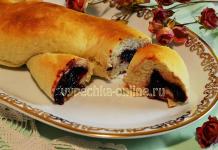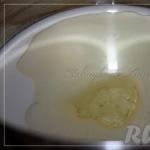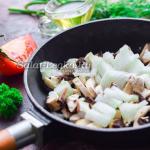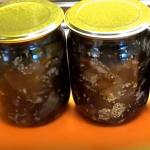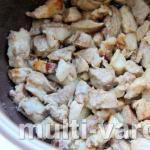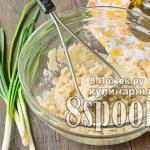Cement particle board is a high-quality and safe material that is actively used in modern construction.
Let’s talk about what it’s good for, what materials can be replaced with it, and most importantly, how to use it.
DSP is a building material, the peculiarity of which is its unique structure.
Cement particle boards consist of crushed pine needle shavings, which are small in thickness but impressive in length.
Length may vary. Feature- at the edges the chips are located along the slab, and inside - across.
This primarily affects the strength indicators.
Advantages of cement bonded particle boards

DSP can be used in areas high humidity, as well as in conditions characterized by a dry climate.
However, this is not the most important advantage of the material. Among other advantages it is worth highlighting:
- versatility. DSP is universal, both in carrying out external repairs and in finishing work inside the house;
- high thermal insulation rates. If we are in which heating is not planned, the house will remain warm in the spring and autumn;
- cement bonded particle boards are easy to install;
- does not require complex processing, is sold in finished form(thanks to this, there is no need to maintain proportions or add impurities, thereby increasing your own chances of making mistakes and damaging materials);
- Bacteria do not multiply in the DSP. The environment that is created in the pores of the material, although safe for humans, is unfavorable for microorganisms;
- can be finished in any way, using any materials (painted, pasted over, plastered, and so on);
- lack of flammability. This can be achieved due to the fact that the CBPB contains cement;
- climate and temperature regime do not affect the structure of materials;
- DSP is not interesting for pests;
- does not contain formaldehyde and other toxic substances that continuously have a negative impact.
As a rule, DSPs are sold in certain sizes. There are 7 size options in total, which differ in length, width and thickness (and, of course, weight, respectively).
Where are cement bonded particle boards used?

How the slabs will be used directly affects the material. It is important to understand that there are two types of DSP: rough and smooth.
They can be used:
- for flooring;
- creating a warm floor;
- like partitions;
- DSP can be used as permanent formwork;
- sheathe frame house;
- room decoration.
A little about smooth... This type of slab is great for interior decoration. It is comfortable, easy to install, and can be covered with almost any type of interior decoration.
When it comes to wallpapering, preparing a DSP for this is easy. In addition, wallpaper adheres well to slabs.
Similarly, DSP is used to create. The floor will be smooth, warm, reliable. If you cover both the walls and the floor with slabs, you can get an almost flat room.
By the way, the use of this material is also typical for the bathroom, since smooth slabs are usually impregnated with a special substance that protects the coating from moisture. No matter how humid the air is, the slabs do not deform.
A DSP board with a rough surface is used outside the rooms of the house.
With its help, you can decorate the walls, leveling them and finishing them to your taste. Plates are used to form roofing pie, formwork, when constructing structures with a obviously small load during use.
By the way, sandwich panels are also made from DSP. This material is suitable for creating paths and paths, which, again, will not withstand heavy loads.
Cement particle boards are also suitable for creating furniture, large warehouse structures, and erecting fences.
Partitions made of cement-bonded particle boards

DSP can be used to create partitions. What is the advantage of these boards compared to the so popular drywall?
The latter is not resistant to moisture, and does not retain heat, but transmits sound perfectly, which can be called a rather negative point.
In combination with DSP with mineral wool or fiberglass, sound insulation can be increased several times.
It lends itself very well to cutting, which is a plus in areas where pipes and wiring pass through.
Finishing the premises with cement-bonded particle boards

Along with the wide choice of applications for the slab, one can note the particular popularity of using it indoors.
| Dimensions, mm | Weight 1 sheet, kg |
Square sheet, m 2 |
Volume sheet, m 3 |
Qty sheets in 1 m 3 |
Weight 1 m 3, kg |
||
|---|---|---|---|---|---|---|---|
| length | width | thickness | |||||
| 2700 | 1250 | 8 | 36,45 | 3,375 | 0,0270 | 37,04 | 1300-1400 |
| 10 | 45,56 | 0,0338 | 29,63 | ||||
| 12 | 54,68 | 0,0405 | 24,69 | ||||
| 16 | 72,90 | 0,0540 | 18,52 | ||||
| 20 | 91,13 | 0,0675 | 14,81 | ||||
| 24 | 109,35 | 0,0810 | 12,53 | ||||
| 36 | 164,03 | 0,1215 | 8,23 | ||||
| 3200 | 1250 | 8 | 43,20 | 4,000 | 0,0320 | 31,25 | 1300-1400 |
| 10 | 54,00 | 0,0400 | 25,00 | ||||
| 12 | 64,80 | 0,0480 | 20,83 | ||||
| 16 | 86,40 | 0,0640 | 15,63 | ||||
| 20 | 108,00 | 0,0800 | 12,50 | ||||
| 24 | 129,60 | 0,0960 | 10,42 | ||||
| 36 | 194,40 | 0,1440 | 6,94 | ||||
Physico-mechanical properties of CBPB TAMAK
Reference indicators of physical and mechanical properties of CBPB TAMAK
| № | Name of the indicator, units measurements |
Value for TsSP-1 slabs | GOST |
|---|---|---|---|
| 1 | Modulus of elasticity in bending, MPa, not less | 4500 | GOST 10635-88 |
| 2 | Hardness, MPa | 46-65 | GOST 11843-76 |
| 3 | Impact strength, J/m, not less | 1800 | GOST 11843-76 |
| 4 | Specific resistance to pulling screws out of plates, N/m | 4-7 | GOST 10637-78 |
| 5 | Specific heat, kJ/(kg K) | 1,15 | - |
| 6 | Biostability class | 4 | GOST 17612-89 |
| 8 | Reduction in bending strength (after 20 cycles of temperature and humidity influences), %, no more | 30 | - |
| 9 | Swelling in thickness (after 20 cycles of temperature and humidity influences), %, no more | 5 | - |
| 10 | Flammability | Low-flammable group G1 | GOST 30244-94 |
| 11 | Frost resistance (decrease in bending strength after 50 cycles), %, no more | 10 | GOST 8747-88 |
Load table for Tamak CBPB “Concentrated load - single-span beam”
| span, mm |
|||||||
|---|---|---|---|---|---|---|---|
| Thickness 8 mm |
Thickness 10 mm |
Thickness 12 mm |
Thickness 16 mm |
Thickness 20 mm |
Thickness 24 mm |
Thickness 36 mm |
|
| 200 | 0,213 | 0,345 | 0,480 | 0,813 | 1,414 | 2,007 | 4,802 |
| 250 | 0,171 | 0,267 | 0,387 | 0,623 | 1,031 | 1,572 | 3,280 |
| 300 | 0,142 | 0,212 | 0,307 | 0,508 | 0,803 | 1,167 | 2,687 |
| 350 | 0,110 | 0,168 | 0,267 | 0,423 | 0,688 | 1,030 | 2,288 |
| 400 | 0,096 | 0,153 | 0,248 | 0,377 | 0,622 | 0,945 | 2,042 |
| 450 | 0,082 | 0,128 | 0,195 | 0,347 | 0,553 | 0,760 | 1,147 |
| 500 | 0,056 | 0,095 | 0,185 | 0,345 | 0,541 | 0,667 | 1,572 |
Thermal properties
DSP, thanks to the organic compound of wood and cement, is a homogeneous monolithic material without air inclusions, which ensures high thermal conductivity. Therefore, DSPs are most widely used in structures that require a combination of high strength and low temperature resistance of the material. Thermotechnical properties of DSP are assessed using the thermal conductivity coefficient, which is the most important thermal indicator building materials.
Dependence of thermal conductivity coefficient on slab thickness
Soundproofing
Insulation index airborne noise
| DSP TAMAK 10 mm | R W =30 dB |
| DSP TAMAK 12 mm | R W =31 dB |
Impact noise insulation index
Cement particle boards with a thickness of 20 and 24 mm, laid directly on the reinforced concrete load-bearing floor of the measuring chamber of the NIISF RAASN, provide improved impact noise insulation by 16-17 dB, respectively.
When laying 20 and 24 mm thick cement bonded particle boards not directly on reinforced concrete slab overlap, and on the intermediate layer of elastically soft material there is an additional improvement in impact noise insulation, amounting to 9-10 dB.
Specific resistance to pulling out screws
| № | Name screw, DxL, mm |
Hole diameter for a screw, mm |
Average specific resistance from 5 tests, N/mm |
Spread of specific resistance, N/mm |
|---|---|---|---|---|
| 1 | 5.5 x 30 | 3,0 | 122 | 118 ÷ 137 |
| 2 | 5.0 x 30 | 3,0 | 85 | 68 ÷ 103 |
| 3 | 4.5 x 30 | 3,0 | 93 | 80 ÷ 108 |
| 4 | 4.0 x 30 (L thread 20mm) |
2,5 | 110 | 88 ÷ 147 |
| 5 | 4.0 x 30 (L thread full) |
2,5 | 114 | 103 ÷ 124 |
| 6 | 3.5 x 30 | 2,5 | 104 | 87 ÷ 116 |
| Wed 105 |
Cement particle boards (CPB) are a whole class of building materials with different characteristics.
They are used for various purposes, using the advantages that they have over traditional finishing and construction materials.
The scope of application directly depends on the type and density of the DSP, so we recommend that you read the articles:
- Production of CBPB: step by step guide, regulatory documents and necessary equipment.
- Fibrolite.
In these articles, we talked about the different types of cement bonded particle boards, as well as the differences in the original components and their proportions.
Even with the same density, the basic parameters of TsSP-1 and TsSP-2 boards are very different from fiberboard boards of any type. This associated with different amounts cement, as well as different requirements for wood filler.
- what can DSP be used for?
- how to choose materials for a particular application;
- what are the advantages of properly selected slabs over other materials;
- how to attach panels to walls or wooden floor what to saw, glue together, prime and how to process the DSP differently;
- how to lay tiles on DSP;
- how to paint the facade of a building on which DSPs are installed, and how to protect this material from moisture and other negative factors.
Here are the main areas in which cement bonded particle boards can be used:
- structural elements (walls and partitions);
- insulation of walls, floors and ceilings;
- soundproofing;
- external and internal finishing;
- permanent insulating formwork;
- creation of greenhouses, beds and other areas.
Structural elements
From DSP you can create various partitions that divide the room into separate zones or parts.

Due to their high rigidity and strength, slabs in this area are not inferior to such materials as:
- wooden board;
- plywood;
However for creating partitions and walls according to technology without a supporting frame, only cement-bonded particle boards with a density of over 1000 kg/m 3 are suitable, and the best results are shown by TsSP-1 and TsSP-2.
Fiberboard boards with equal density are less durable, because they contain less cement.
However, full walls large size it will not be possible to make one from this material due to the size of the sheet, because the maximum width does not exceed 125 cm, so the sheets will have to be stacked on top of each other.
Therefore, to create full walls and large partitions a supporting frame is required, but the same limitation applies to others structural elements, comparable in size.
The exception is cases when it is possible to place cement-bonded particle boards vertically and securely fasten them at the top and bottom.
Moreover, such a wall will only fulfill decorative function and is not designed for any kind of force.
With a slab thickness of 30–50 mm, a door or arched opening can be embedded into a wall of this design, the main thing is that its width does not exceed 1.5 times the width CBPB slabs.
If the width of the area that needs to be partitioned does not exceed the width of one sheet, and there is no force impact on it, then you can use a material with a thickness of 10–15 mm (when using fiberboard boards, the thickness must be increased to 20 mm).
Moreover, compared to other structural materials, the same DSP thickness will provide much higher level of noise and heat insulation.
Insulation for house facades and walls, floors, ceilings
To insulate a house, you can either use DSP inside or cover the façade of the house with this material. It is better to use cement-bonded particle boards of any type as insulation. with a density of 250–350 kg/m 3, however, fiberboard is more effective due to less cement.
Despite the low density, the strength of sheets of any thickness is sufficient to be attached to the wall either with glue or with anchor nails.
 DSP is somewhat less efficient compared to foam plastic (thermal conductivity of boards is 0.06, foam plastic is 0.04), but they freely allow water vapor to pass through, due to which the premises always maintain a favorable dry climate.
DSP is somewhat less efficient compared to foam plastic (thermal conductivity of boards is 0.06, foam plastic is 0.04), but they freely allow water vapor to pass through, due to which the premises always maintain a favorable dry climate.
DSPs are only slightly inferior mineral wool(the thermal conductivity of slabs with a density of 300 kg/m 3 is 0.06, and that of wool is 0.05), but an increase in humidity does not affect their characteristics.
In addition, their can be installed on flat surfaces without a special frame, and to protect against precipitation, a thin layer of plaster or even waterproof, vapor-permeable paint is sufficient.
Despite the fact that polyurethane foam is easier to apply, working with it requires expensive, highly specialized equipment, the price of which starts from 40 thousand rubles.
Besides, polyurethane foam does not allow water vapor to pass through at all, therefore, after insulating it in houses with a not very good ventilation system, the climate becomes damper, and mold and rot also appear.
The costs for working with any type of DSP are much lower, and the equipment can be used for many other jobs.
When insulating ceilings, cement particle boards are hemmed from below using glue and anchor nails or self-tapping screws. However, this method of application can only be used in houses and apartments with durable floors and reliable ceiling lining.
Fiberboard boards with a density of 250–350 kg/m3 are best suited for this work, because they contain more wood than products of the TsSP-1 and TsSP-2 brands. Maximum thickness slabs depends on the strength of the floor and the ability to securely attach the insulation to it.
Using this material, it is possible to completely construct and install the roof of a house, as well as build the entire house as a whole.
 To insulate the floor, the slabs are laid either on concrete screed, or on the rough flooring.
To insulate the floor, the slabs are laid either on concrete screed, or on the rough flooring.
If the base is not too level, then to level the floor it is advisable to pour a layer of solution, this will allow the maximum potential of the DSP to be realized.
After all, all materials of this type, manufactured according to GOST or international standards, are identical in thickness and have a smooth surface.
Thanks to this, it will be possible to lay parquet, laminate or linoleum on them without additional layer. The optimal density of material such as TsSP-1 and TsSP-2 is 500 kg/m 3 , the optimal density of fiberboard is 800–900 kg/m 3 .
The technique is used quite often laying CBPB on the floor along wooden logs, and the thickness and density of the slabs required to ensure the strength of the floor in the house, in this case, will depend on the distance between the installed logs.
Laying DSP on the floor, including wood, under tiles is ideal option in the bathrooms.
To begin the installation of tiles, it is enough to use cement-bonded particle boards Apply a couple of coats of regular primer to improve adhesion.
If it is necessary to insulate the base of a heated floor, including if it is mounted under tiles, then the density of the sheets depends on its design. If the heating element is immured in the screed, then it is advisable to use slabs density 300 kg/m 3.
If the heating element is laid between wooden or aluminum supports, then it is advisable to use a material of the same density as for a regular floor.

When insulating the floor with cement-bonded particle boards, it is necessary to ensure reliable waterproofing, since the water that gets under the front covering will be absorbed into the insulation, but will have difficulty going back due to poor air exchange.
Long exposure to high humidity will reduce strength cement-chip floor and will lead to the appearance of mold and rot in the chips, which will negatively affect its thermal insulation properties.
Soundproofing
Residents of Soviet-built multi-storey buildings suffer greatly from poor sound insulation, because in the apartments you can hear everything that happens at a distance of several floors. Often even residents of private houses are looking for ways to improve sound insulation to reduce the level of noise coming into the rooms from the street.
Low-density cement-bonded particle boards, although inferior to many modern materials with the same thickness, but due to their minimal cost and ease of installation on walls, floors, etc., they are very popular.
The most effective in this area are fiberboards of the GB-1 standard and their magnesite analogues.
The maximum soundproofing effect is achieved not only by increasing the proportion wood waste, but also located along the slab. However, TsSP-1 and TsSP-2 slabs with a density of 250–350 kg/m 3 are also good for noise reduction.
 To increase the sound insulation effect between the slabs and the wall/ceiling, you need lay a layer of felt 2–6 mm thick.
To increase the sound insulation effect between the slabs and the wall/ceiling, you need lay a layer of felt 2–6 mm thick.
Having sheathed the ceiling with slabs 2–3 cm thick and laid felt, you lower the level entering the apartment noise tenfold. In this case, it is important to join the slabs tightly so that there are no gaps between them, otherwise the effectiveness of such sound insulation will sharply decrease.
For exterior work and interior decoration
The purpose of exterior and interior decoration is to hide wall defects and make the exterior or interior more attractive. All types of DSP are well suited for rough finishing, over which a fine finish can be applied.
Cement particle boards of any type have high strength, but cannot be used for exterior finishing material with a density of less than 700 kg/m 3, and for internal less than 1000 kg/m 3.
As the density increases, the rigidity and strength of the product increase, which is especially important in regions with frequent strong winds.
Interior finishing material must be able to withstand the screw being screwed in with a small load, therefore, the use of low-density cement particle boards for interior decoration is unjustified.
In most cases this finishing material must be attached to a special frame that compensates for the unevenness of the walls. In addition, the frame ensures air movement under the finish, due to which condensation on the wall evaporates faster and does not lead to an increase in humidity of the wall or finish.
 If the frame is made correctly, then after installing the slabs they form flat surface, so it’s enough to fill the seams between them with mortar or putty, after which walls are ready for finishing.
If the frame is made correctly, then after installing the slabs they form flat surface, so it’s enough to fill the seams between them with mortar or putty, after which walls are ready for finishing.
The most effective finishing materials are TsSP-1 type slabs with a polished surface.
They are attached to the frame using appropriate self-tapping screws - wooden blocks require wood-carved screws, aluminum or steel profiles require metal-threaded screws.
As an interior decoration, sheets based on chip concrete have a significant advantage - they do not emit toxic substances, which cannot be said about:
- plywood;
- plastic;
The only materials that can provide significant competition in terms of environmental safety, This natural board and real MDF, made without the use of glue.
However, they have serious disadvantages compared to cement bonded particle boards:
- less rigidity, forcing an increase in the thickness of the finish;
- much higher flammability;
- higher price.
Therefore, as an environmentally friendly material for interior decoration, all types of DSP have no equal in terms of the totality of all parameters.
- do not emit toxic substances in normal conditions;
- able to withstand for a long time high temperature before the start of the pyrolysis process in sawdust;
- do not support combustion and go out after the source of open fire disappears;
- even during a fire they do not emit toxic substances, with the exception of carbon monoxide and carbon dioxide, but these substances are released during combustion by any organic matter;
- albeit insignificantly, they perform the functions of insulation and sound insulation.
For the exterior decoration of the facade of a house, the most popular are cement-bonded particle boards and panels of the TsSP-1 type with a density of 1100–1400 kg/m3 and a thickness of 1 cm.
At correct selection distances between the frame slats, such decoration of the house outside easily withstands wind speeds of 40–50 m/s. An example of finishing the facade of a house is shown in the photo below.

Fiber cement boards of the same density must be chosen with a greater thickness due to the lower cement content, so most often for external work a material with a thickness of 15–20 mm is used. He has the same resistance to precipitation and wind load.
Between the wall of the house and the finishing, you can install insulation made of shavings and cement, which has excellent reviews, or other material.
Due to the fact that during rain, water quickly drains from the surface of the façade cladding panels, the slabs do not have time to absorb much water, so even in the event of a sharp drop in temperature after prolonged rain, they will not suffer severe damage.
Treatment with hydrophobic paints for exterior use and preparations that do not affect vapor permeability, further reduces the material’s ability to absorb water.
Thanks to this, any type of DSP as an exterior finish is in no way inferior to traditional plaster.
Due to such properties of the material, its lightness finishing(painting), as well as based on numerous reviews from residents, cladding the façade of a house with DSP can easily be called the best option for climatic conditions many regions of Russia.
 In addition, manufacturers also produce non-requiring additional finishing facade panels for cladding houses, including wooden frame ones, performing at the same time a decorative function.
In addition, manufacturers also produce non-requiring additional finishing facade panels for cladding houses, including wooden frame ones, performing at the same time a decorative function.
For example, façade and plinth panels to look like stone, like brick, like crumbs and others.
These façade panels are used to finish the foundation of a house, the basement, including screw piles.
Do-it-yourself permanent insulating formwork
Construction of houses from monolithic concrete is gaining more and more popularity because it allows you to build walls much faster than any other methods.
Permanent formwork not only creates a form for concrete, but performs a warming function, due to which, after the concrete has gained full strength, the wall is completely ready for finishing and does not require additional insulation.
The only one competitor cement bonded particle boards in this application – permanent formwork made of expanded polystyrene(PPS), however, it completely blocks the vapor permeability of the walls, which is why problems begin in houses with a not very good ventilation system.
Unlike polystyrene formwork, which is supplied in the form of ready-made blocks small size, formwork made of cement bonded particle boards need to make it yourself.
 As in the case of EPS formwork, DSP formwork must be carefully reinforced with numerous bridges to avoid squeezing out the slab with concrete.
As in the case of EPS formwork, DSP formwork must be carefully reinforced with numerous bridges to avoid squeezing out the slab with concrete.
This is especially true when using heavy concrete, but it will not be superfluous when pouring foam concrete.
In addition, it is necessary strengthen formwork over the entire area using various pegs and spacers, which will protect it from shifting during filling with concrete and its compaction.
It is advisable to use sheets for the manufacture of formwork density over 1000 kg/m 3, and the thickness of the sheet directly depends on the desired thermal insulation effect.
Therefore, sometimes double formwork is made - an internal sheet of fiberboard with a density of 1200–1400 kg/m3 and a thickness of 10 mm is installed, and a sheet of fiberboard with a thickness of 50–100 mm and a density of 300 kg/m3 is placed close to it.
When using foam concrete, such a design will ensure such a low level of heat loss that even in conditions northern regions no additional insulation required.
However, permanent formwork made from DSP also has minus- her cannot be used below ground level, since under the influence groundwater Over time, wood will lose its thermal insulation properties, and cement stone will collapse.
But as formwork interior walls DSP has no equal, because after the concrete has hardened, the wall surface is ready for finishing, and it also has, albeit small, a heat and sound insulating effect.
Greenhouses and beds
Cement particle boards, even when buried in the ground, capable of standing like this before destruction for several decades, due to which they are often used to create do-it-yourself or fencing greenhouses and beds. After all, boards without special treatment will rot into dust in 3–5 years, and DSP will last 20–40 years without requiring replacement.
 Most often, plates are used for this density over 1000 kg/m 3 and thickness 8–12 mm.
Most often, plates are used for this density over 1000 kg/m 3 and thickness 8–12 mm.
Another advantage of cement-bonded particle boards is that greenhouses and garden bed fencing made from CSP look very neat thanks to the smooth walls.
The same effect is created by the carriage board, but its service life and high price do not allow it to compete with CBPB.
Chipboard, plywood and other similar materials also cannot compete with these boards, because even those that are called waterproof quickly collapse when they are in the ground.
If the wall height is small, you can do without a frame by connecting the slabs together using plastic corners, if the height or length of the structure requires the use of several slabs, you cannot do without a frame.
As a frame, you can use either boards impregnated with hydrophobic compounds (such compounds spoil the soil) or structures based on large-diameter polypropylene pipes.
If the diameter of the pipe exceeds 30 mm, and the design of the frame is well thought out, then the greenhouse or bed turns out to be quite strong.
You can reduce the diameter of the pipes by inserting pieces of metal or fiberglass reinforcement into them, but in this case you will have to attach the DSP use short jumpers.
Due to the fact that the cost of a sheet rarely falls below 500 rubles, many people prefer used cement particle boards that were dismantled during repairs.
Such DSPs do not have very good appearance, and their strength is much less than new ones, but they are quite in demand for fencing beds and creating greenhouses, as can be concluded from numerous reviews from gardeners. Moreover you can buy them very cheap or get it for free.
In addition to the areas listed applications of DSP due to its properties and affordable cost, it is also used to build bathhouses with your own hands, including floors in it, lining garages, sheds, building fences, mounted on roofs, etc.
Processing and installation of sheets
Cement particle board, in its physical characteristics, is very different from most finishing materials, so its processing occurs according to a special algorithm and using special tool.
Violation of the work algorithm and the use of inappropriate tools are often leads to material damage and the need to replace it, and given the considerable price of any type of DSP, including, for example, sheets for floors or slabs for facades such as brick or tile, this attitude turns out to be extremely unprofitable.
What to cut with?
 To cut this material you will need hand circular saw, equipped with a disk with carbide (pobedite) nozzles or diamond-coated teeth.
To cut this material you will need hand circular saw, equipped with a disk with carbide (pobedite) nozzles or diamond-coated teeth.
If there is no such disk, you can use a suitable size abrasive cutting disc for stone with a bore diameter of 32 mm.
If you need to cut a sheet or cut a hole in it rectangular shape, then place it on a flat table so that the cutting line is 2–4 cm away from the edge.
Required for cutting use a respirator and safety glasses, and also do not forget to fasten the sleeves of your clothes. Place the saw blade on the sheet so that the blade is 3–5 mm away from it.
Turn on the saw, then smoothly move it forward so that the blade follows the cutting line. The speed of the saw depends on the density and thickness of the sheet, so rely on your own feelings.
At normal speed, the sound of the saw engine hardly changes, but forward movement resistance is minimal.
If the sound changes (the speed drops) or the resistance to movement increases, then you are moving the saw forward too quickly, which is why the blade does not have time to cut the cement stone properly. To reduce the amount of dust and improve the quality of the cut, you can water the sheet along the cutting line.
If the dimensions of the cut piece exceed 20 cm on any side for thin slabs and 10 cm for thick ones, then an assistant must support the cut piece so that it does not break off.
Care must be taken so that your fingers do not get in the path of the saw.
To cut a round or oval hole, you must first draw it on a sheet of paper, then write a rectangle into it. Moreover, the distance from the drawing to the edge of the rectangle should never be less than 3 cm.
 If you know how to cut circular saw not from the edge of the sheet, then cut out a rectangle for it; if not, then use a grinder(angle grinder, angle grinder) With abrasive disc on stone.
If you know how to cut circular saw not from the edge of the sheet, then cut out a rectangle for it; if not, then use a grinder(angle grinder, angle grinder) With abrasive disc on stone.
Having cut out a rectangle, mark parallel strips on the remaining parts of the slab inside the pattern in increments of 1–1.5 cm, running from the edges of the rectangle to the edge of the pattern. Cut these strips 3–5 mm short of the edge of the pattern.
Then cut through sheet according to the drawing using a jigsaw with a diamond file, designed for cutting glass or ceramics.
This sequence of actions increases the time required to cut a hole, but greatly reduces the chances that you will ruin the material. After all, when cutting a hole with a diameter of over 40 cm, there is a possibility that the cut piece will break off, and the fracture line will affect the remaining sheet.
If you are a skilled, experienced finisher and therefore know how to work well with materials such as:
- ceramic tiles;
- smooth slate,
then you can cut or saw oriented strand board than you are used to, because the behavior of these materials when cutting is very similar to the behavior of OSB of any type.
- self-tapping screws;
- anchor screws (dowel-nails);
- rivets.
Self-tapping screws are well suited for fastening DSP to a wooden or metal base.
If you only have ordinary hardened self-tapping screws, then you need to drill a hole in the slab for them, and also countersink the space for the head. Without this, the cap will protrude above the surface of the slab, which will create great difficulties during finishing.
You can screw in reinforced screws without drilling, the caps of which are equipped with knives and cut a hole for themselves. The diameter of the hole for a regular self-tapping screw is equal to 1.2 times the diameter of the screw itself, and the diameter and depth of the hole for the head are 1.5 times larger than the size of the head.
It is not advisable to use ordinary screws for fixation, because they do not have the required strength, so with their help you will not be able to properly tighten the slab to the base.
After installing the screws, the holes for the caps must be sealed with putty, and after drying, treat it with sandpaper.
Anchor screws are used in cases where the panel needs to attach to concrete or wooden wall . To do this, place the plate in place and drill a hole for the plastic dowel. For fastening low-density slabs (300–500 kg/m3) It is advisable to use dowels with large heads for more effective fixation.
Such caps distribute the pressure created by the dowel-nail over a large area, so that the cement stone does not receive damage. In high-density slabs (over 700 kg/m3), everything is done in the same way as when fixing with self-tapping screws.
 Rivets use for quick fixation to steel or aluminum profile
, where for some reason it is impossible to use self-tapping screws.
Rivets use for quick fixation to steel or aluminum profile
, where for some reason it is impossible to use self-tapping screws.
To do this, the sheet is put in place, then a hole is drilled, the diameter of which is 1.2 times larger than the diameter of the rivet.
After this it is necessary using a special cutter to select mounting hole under the rivet head.
If this is not done, the cap will protrude above the surface of the slab. Use instead of a cutter regular drill also not possible, because The cutter makes a hole with a flat bottom, to which the cap will be pressed tightly, and the drill makes a conical hole.
The cap will not be able to press evenly against such a hole, so over time the fastening will weaken and the plate will begin to dangle. If there is no cutter, it is better to leave the rivet heads outside; they can be covered with a thin layer of plaster. This will be better than using a drill.
Finishing
The front surface of any cement bonded particle board is very smooth, so after covering the walls of a house with this material, it is enough to carry out only the final finishing.
To do this, first carefully putty the seams, trying not to stain the slabs too much. Then, when the putty dries, joints and seams clean with sandpaper.
After this, wallpaper is pasted, painted or any other finishing option is performed.
To apply wallpaper, use glue that is suitable for the selected type of wallpaper and is suitable for brick or concrete surfaces. For laying ceramic tiles, use only cement based adhesive, because it has the same temperature expansion as the DSP, so it will not crack due to temperature changes.
During the work, the glue is dosed with a special notched spatula.
If you decide to paint the walls, then use any vapor-permeable paints and varnishes, suitable for painting brick or concrete surfaces.
Video on the topic
Below is a video taken by one of the construction companies Russia, about the advantages of constructing residential buildings from cement-bonded particle boards using the example of one of these buildings. As you can see, the facade of a house made of this material is ready for painting immediately after its construction:
Conclusion
Cement particle board is a modern finishing material, but it is most effective only when used correctly.
After reading the article, you learned:
- what is DSP used for?
- how this material is cut and drilled;
- how slabs are attached to various surfaces;
- is it possible to lay tiles on DSP, and how to glue them;
- Is it possible to use this material in a steam room, including for installing a floor in a bathhouse?
- what types of finishes are applied to walls covered with fiber board frame house.
How to quickly and efficiently, but at the same time with minimal waiting time, level the floors in an apartment or house? If the speed of work is very important, and even the creation of a regular cement screed impossible, then a DSP board is perfect for this purpose. The use of this building material for flooring allows you to make surfaces smooth very quickly. In this case, the coating will be durable and of high quality.
DSP board - application for flooring
DSP is a cement-bonded particle board, and the name fully reflects the composition of this material. DSPs are made from a mixture whose components are wood shavings and cement compounds.

The building materials include:
- wood shavings with fractions of various sizes – 24%;
- water – 8.5%;
- special additives – 2.5%;
- Portland cement – 65%.

The production process is quite simple - DSP is made as follows.
- Special mixers are loaded with special aqueous solutions, which include various salts, liquid glass and aluminum.
- Next, wood shavings with fractions are gradually added to these solutions different sizes– mineralization of raw materials occurs.
- Cement is mixed into the resulting composition and a little more water is added.
- The mass is thoroughly mixed until smooth and then goes under a powerful press.
GOST 26816-86. Cement particle boards. Specifications. Downloadable file (click the link to open the PDF in a new window).
The result of this production chain is a finished cement bonded particle board, which is quite thin and has a smooth surface. And a large amount of cement in the composition allows you to create a fairly durable material. By the way, inside the slab the chips have O larger dimensions than the outside, due to which the smoothness of the surface of the finished material is achieved. DSP does not need to be further leveled after installation, making the material excellent for creating a rough floor covering for laminate, tiles and other types of finishing. Also, no voids are formed inside the DSP during production.

Note! Wood shavings are also used as raw materials in the production of chipboard, fiberboard and OSB boards. The technologies for producing these materials are somewhat similar to the technology for producing CBPB boards.

DSP boards are widely used in construction. They can be used for finishing façade walls houses, from which various partitions are created indoors. The material is suitable for use for restoration purposes and for internal finishing works. Moreover, it is suitable for both apartments and private houses.

The DSP board is characterized by high environmental friendliness, as it is created from natural materials and practically does not contain additional chemical ingredients. That is why the stove is recommended for use both in residential premises and in production.

Using a cement bonded particle board is an opportunity to avoid the labor-intensive pouring of cement screed to create a base. The building material allows you to reduce labor costs and spend less money from the budget planned for leveling floors for laying the finishing coating.

DSP plates
Characteristics of CBPB boards
DSP is a completely new category of material, characterized by significant strength, long service life, and a certain level of moisture resistance. It also has good soundproofing and heat-saving properties. All these features have allowed CBPB boards to take a strong place in the construction industry - they are used for various purposes.
Of course, this material is far from ideal, but still, thanks to its properties and characteristics, it can be used both outside and inside the building. The DSP board does not lose its qualities in a wide variety of climatic conditions.

Note! Compared to chipboard, which is common for many, a board based on cement and shavings is 3 times stronger and has high resistance to various physical influences and loads.
Table. Key parameters of the DSP.
| Length, m | Thickness, mm | Width, m | Area, sq. m. | Number of sheets in 1 cubic meter, pcs. |
|---|---|---|---|---|
| 2,7 | 8 | 1,25 | 3,375 | 37 |
| 2,7 | 10 | 1,25 | 3,375 | 29 |
| 2,7 | 12 | 1,25 | 3,375 | 24 |
| 2,7 | 16 | 1,25 | 3,375 | 18 |
| 2,7 | 20 | 1,25 | 3,375 | 14 |
| 2,7 | 24 | 1,25 | 3,375 | 12 |
| 2,7 | 36 | 1,25 | 3,375 | 8 |
| 3,2 | 8 | 1,25 | 4 | 31 |
| 3,2 | 10 | 1,25 | 4 | 25 |
| 3,2 | 12 | 1,25 | 4 | 20 |
| 3,2 | 16 | 1,25 | 4 | 15 |
| 3,2 | 20 | 1,25 | 4 | 12 |
| 3,2 | 24 | 1,25 | 4 | 10 |
| 3,2 | 36 | 1,25 | 4 | 7 |
The density of one cubic meta CBPB board is quite high - about 1300-1400 kg/m3. The moisture content of the material is 6-12%. By the way, the material is not 100% protected from the effects of water, but swelling upon contact with liquid over a full day should not exceed 2%.

The slab is rough to the touch, but smooth - often these indicators depend on the grinding method used. Sometimes the DSP does not need the latter - if the roughness level is no more than 80 microns. The plate is selected in accordance with the operating conditions, as well as the requirements for the final results. For example, smooth slabs are usually used indoors, but rougher slabs can be used outside.
Note! Finishing of DSP boards is simple - any type of floor finishing can be laid on them, and paint, varnish, plaster, etc. can be easily applied to the surface.

Cement particle board - transportation
Advantages and Disadvantages
What are the main advantages and disadvantages of slabs over other similar materials? Let's look at the answer to this question in more detail.

Advantages of DSP:
- environmental friendliness of the material, as it is made from natural ingredients. DSP does not contain asbestos and formaldehyde-containing substances;
- fungus and mold do not settle on the slabs;
- the material is not hygroscopic - this is its main advantage over chipboard;
- DSP does not suffer from temperature changes and does not lose its performance qualities;
- 100% non-flammability of DSP boards allows them to be used in any room. The material can withstand fire for 50 minutes;
- reasonable price, allowing you to purchase material even if you have a small budget;
- significant strength due to multi-layer material. Excellent performance is observed under pressure both from the end of the plate and from any of the other sides;
- the slab does not require additional leveling of surfaces;
- the material is not afraid of chemical influences;
- cement particle board perfectly resists rotting processes;
- relative impermeability to water - during the day, DSP is able to absorb a maximum of 16% of liquid;
- high noise insulation and heat insulation qualities;
- ease of installation.

Note! It is recommended to use DSP boards when installing a water supply system. heated floors. In this case, it will be possible to create an additional air gap between the heating and finishing coat, which will significantly improve the result of the work done.
The disadvantages of plates are as follows:
- large mass of material, which makes working with it difficult;
- During processing, the DSP generates a lot of dust. If you have to cut slabs, you should wear a respirator and safety glasses to avoid harm to your eyesight and respiratory organs.

However, the material has many more advantages than disadvantages, which explains its popularity in construction, including for leveling floors. Typically, CBPB slabs are laid on logs - this is best option application of the material in this area. More often, DSP is installed under laminate, carpet, linoleum, and ceramic tiles.
In general, it can be noted that in most respects, CBPB boards are superior to plasterboard, chipboard and fiberboard, which makes them one of the best building materials. Also, DSP will save a lot of money if a choice is made in their favor.

DSP in insulation works
Most often, DSP is used in the field of insulation of buildings and structures. Usually the material is sheathed on the outside of the building. Fixation is done using self-tapping screws or nails.
But, since DSP is an environmentally friendly material, wall and floor cladding can also be done from inside the room. The sheathing process is similar to what is done outside: the material is attached to a wooden or metal sheathing using nails or self-tapping screws. Sometimes adhesive mastics can also be used. After installation of the slabs, finishing is carried out.

Application for floor
DSP is often used to create a subfloor. Most often, the material is laid with the expectation that in the future ceramic tiles will be glued to it - this is the most demanding coating in terms of the evenness of the base. DSPs are also suitable for pouring and installing soft floor coverings.

DSP slabs can be mounted on logs, and also laid on a flat concrete or wooden base. Serves material for many years and at the same time is able to withstand significant loads if installed correctly.

DSP slabs for flooring - photo
Choosing cement sheets for the floor
The choice of DSP boards is carried out in accordance with the conditions in which the material will be used, as well as the technology by which its installation will be carried out. For laying on logs, slabs with a thickness of 20-26 mm are used - they will perfectly cope with their function as a rough base. If installation is carried out directly on the ground, then 24-26 mm slabs are used. In general, almost any DSP board can be used to level floors.

Note! DSP boards can be laid even in cold weather. It doesn’t matter if the air temperature outside the window drops below zero.
Requirements for CBPB slabs used for floor installation:
- humidity – from 6 to 12%;
- density – more than 1300 kg/m3;
- tensile strength – 0.4 MPa;
- surface roughness – 80 microns;
- moisture absorption level – 16%.

Preparing for the installation of a DSP coating
Before starting construction work rough coating The base of the floor made from CBPB must be properly prepared. For example, when laying material on a wooden base, old or rotten boards must be dismantled and replaced with new ones. It is important to seal all cracks with putty, and the wooden base is primed for better adhesion to the glue on which the slab covering will be mounted.
If installation will be carried out on a concrete base, then it should also be carefully inspected for damage and repaired if necessary. Also, if there are strong horizontal deviations, alignment is performed cement mixtures. In the case of laying CBPB on the ground, it is necessary to first level the surface - this can be done by pouring it onto the ground sand and gravel mixture 20 cm thick and compacted it.

The best option is to lay CBPB slabs on logs. In this case, if it is planned to install the base directly above the ground, supports for the logs are installed on the ground, and hydro- and thermal insulation is also laid. The distance between the supports can vary from 0.5 to 1 m - this indicator depends on the thickness of the timber used for the logs.
Materials and tools that need to be prepared for working with DSP:
- timber for logs (section 150x100 or 50x100 mm);
- DSP boards in the required quantity;
- antiseptic solution for timber;
- sawing tool (for example, a hacksaw);
- materials for waterproofing and insulation;
- tools for taking measurements (tape measure, pencil);
- fastening material;
- drill.

Arrangement of the floor using DSP
Let's consider the arrangement of a floor made of cement-bonded fiberboard on joists using the example of a balcony.
Step 1. A layer of insulation is placed under the joists. The logs are installed parallel to the walls at a distance of about 30-40 cm from each other.

Step 2. Cross bars are installed and the sheathing is created. Between each other wooden blocks connected using metal corners and self-tapping screws.

Step 3. The space between the joists is filled with insulating material.

Step 4. DSP boards required sizes laid across the longitudinal joists. The width of the piece of material should be slightly less than the width of the balcony (by 5-10 mm).

Step 5. The slabs are fastened with self-tapping screws to the joists. The gaps between the DSP boards are sealed with an adhesive composition.

Video - Laying tiles on DSP
DSP floors: laying nuances
In general, the installation of CBPB boards is carried out in exactly the same way as the installation of OSB boards. When carrying out work, it is important to follow several rules, and then the base of the floor will be made of the highest quality:
- wooden beams for logs must be treated with compounds that prevent rotting. Special compounds can be replaced with machine oil;

- When installing slabs on a concrete screed, beams of a smaller cross-section can be used for logs - up to 50x50 mm. This will save useful space;
- when installing logs, you should monitor their level - it must be strictly horizontal;
- Before installation, the CBPB boards are laid out along the joists - this will allow you to determine which of them need trimming if necessary;
- the glue must be mixed well before use;
- Compensation gaps along the walls will allow you to avoid deformation of the DSP base.

DSP is a pretty good material if you use it to create a flat base. It is not difficult to work with it, but due to the large mass of sheets, it is better to get an assistant.


